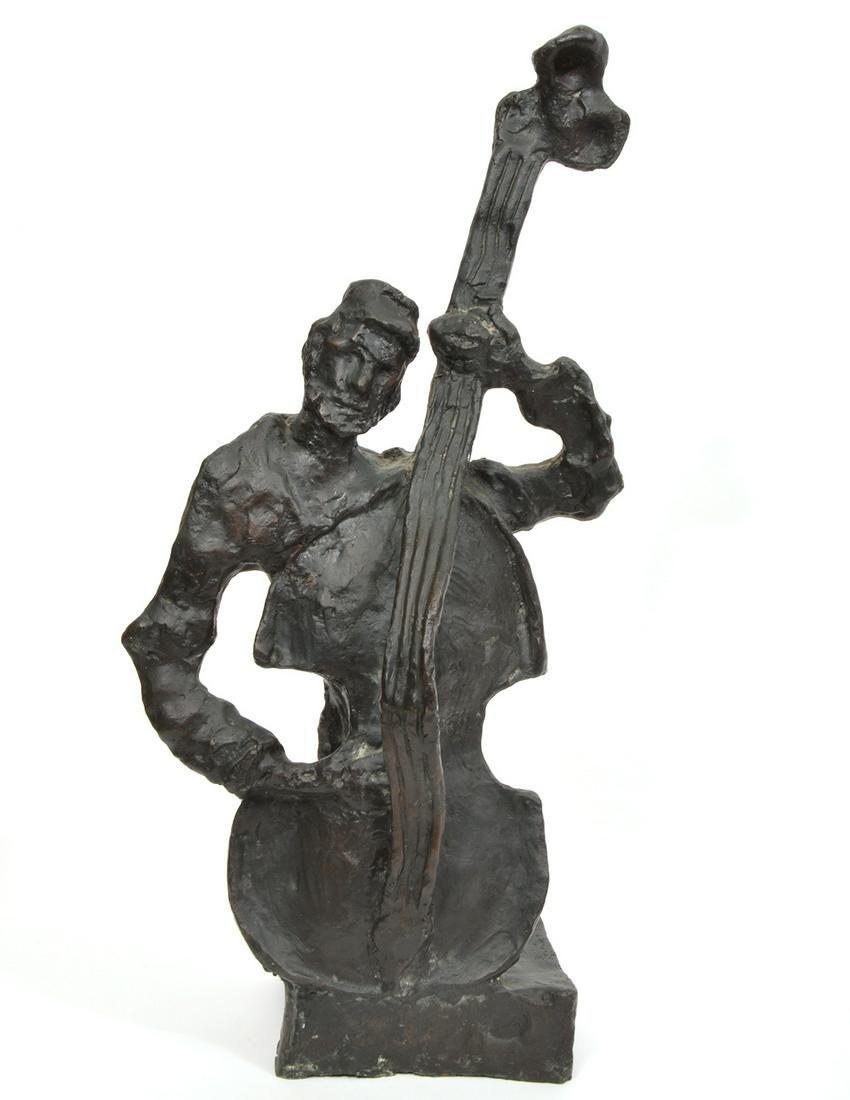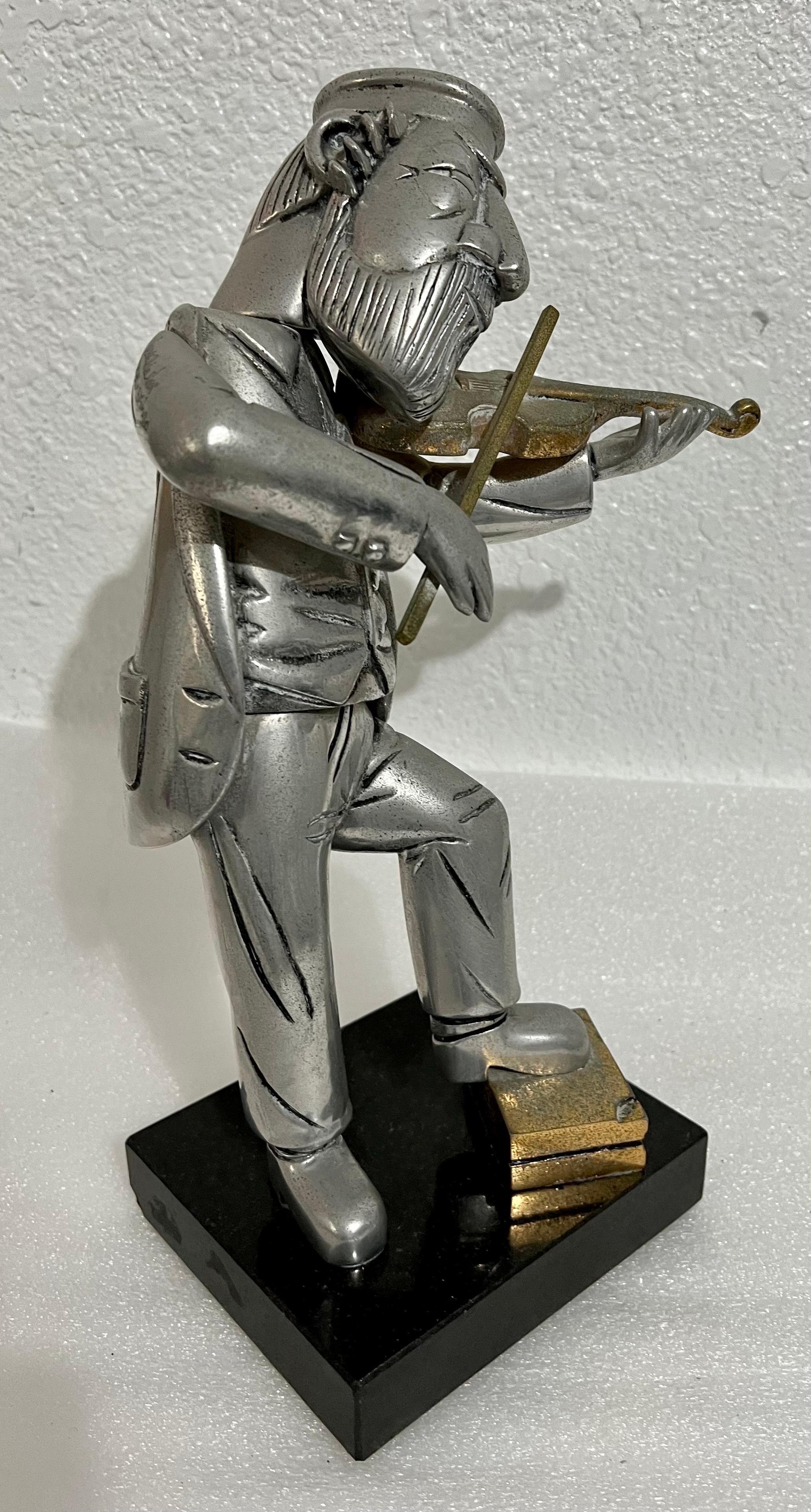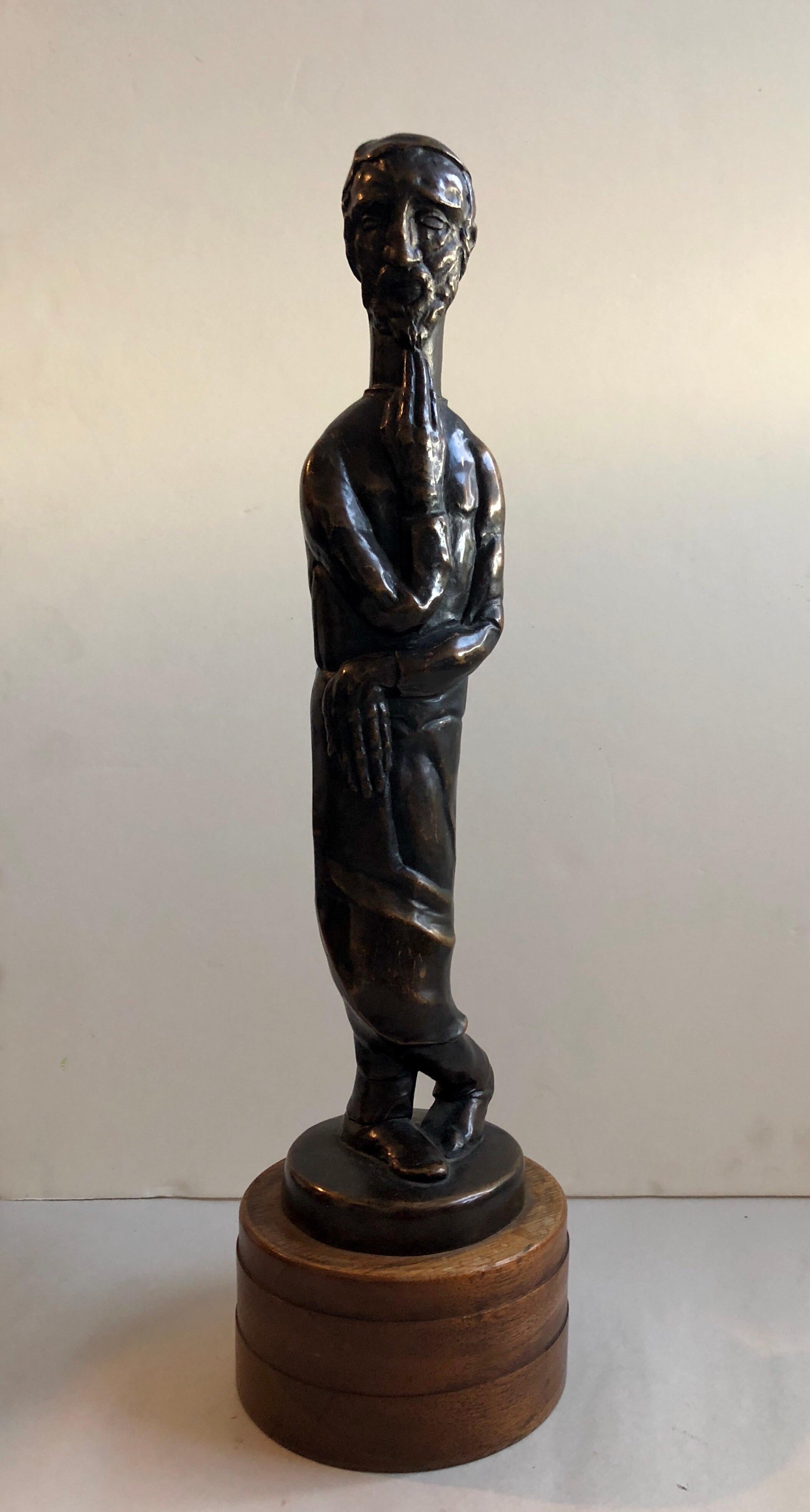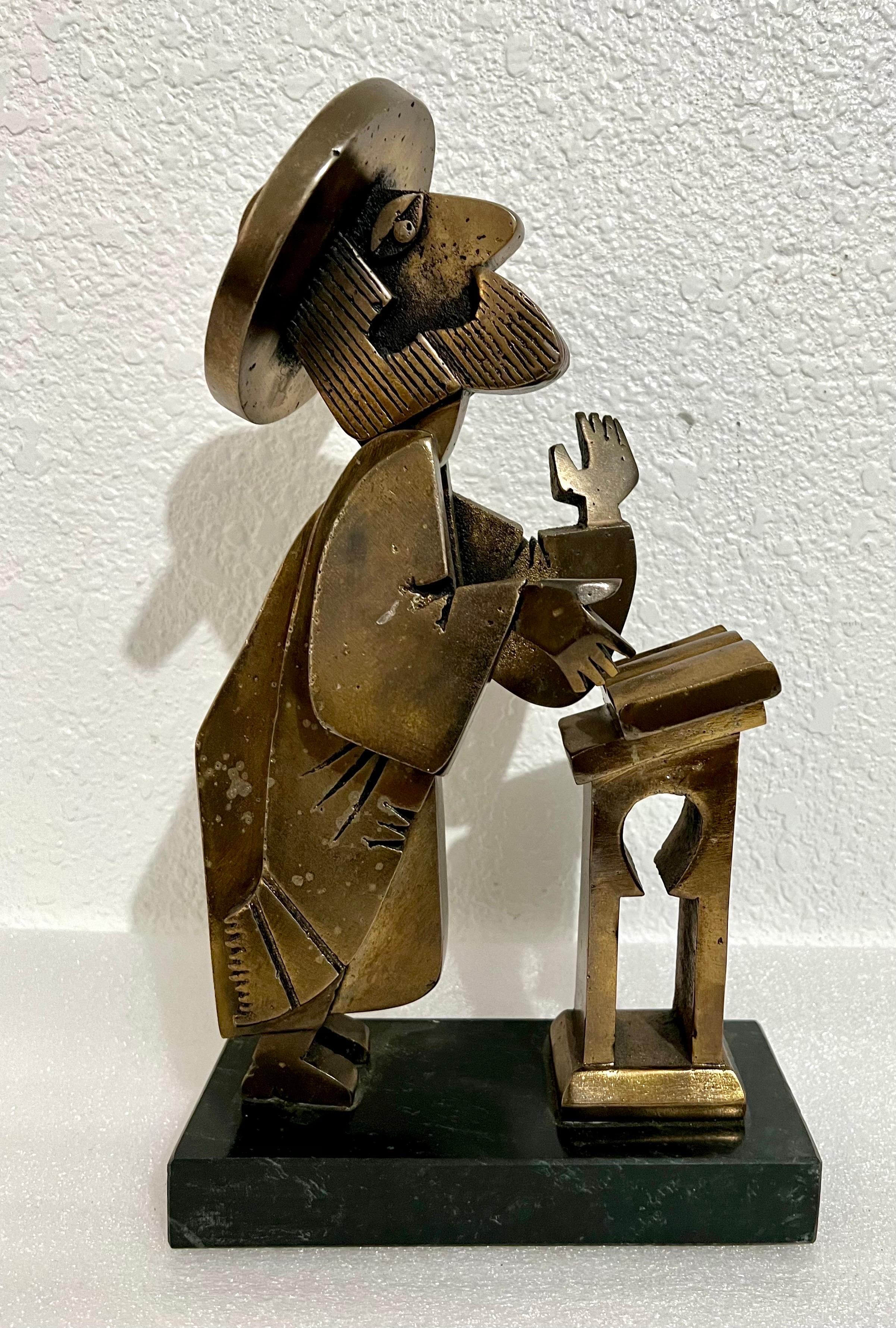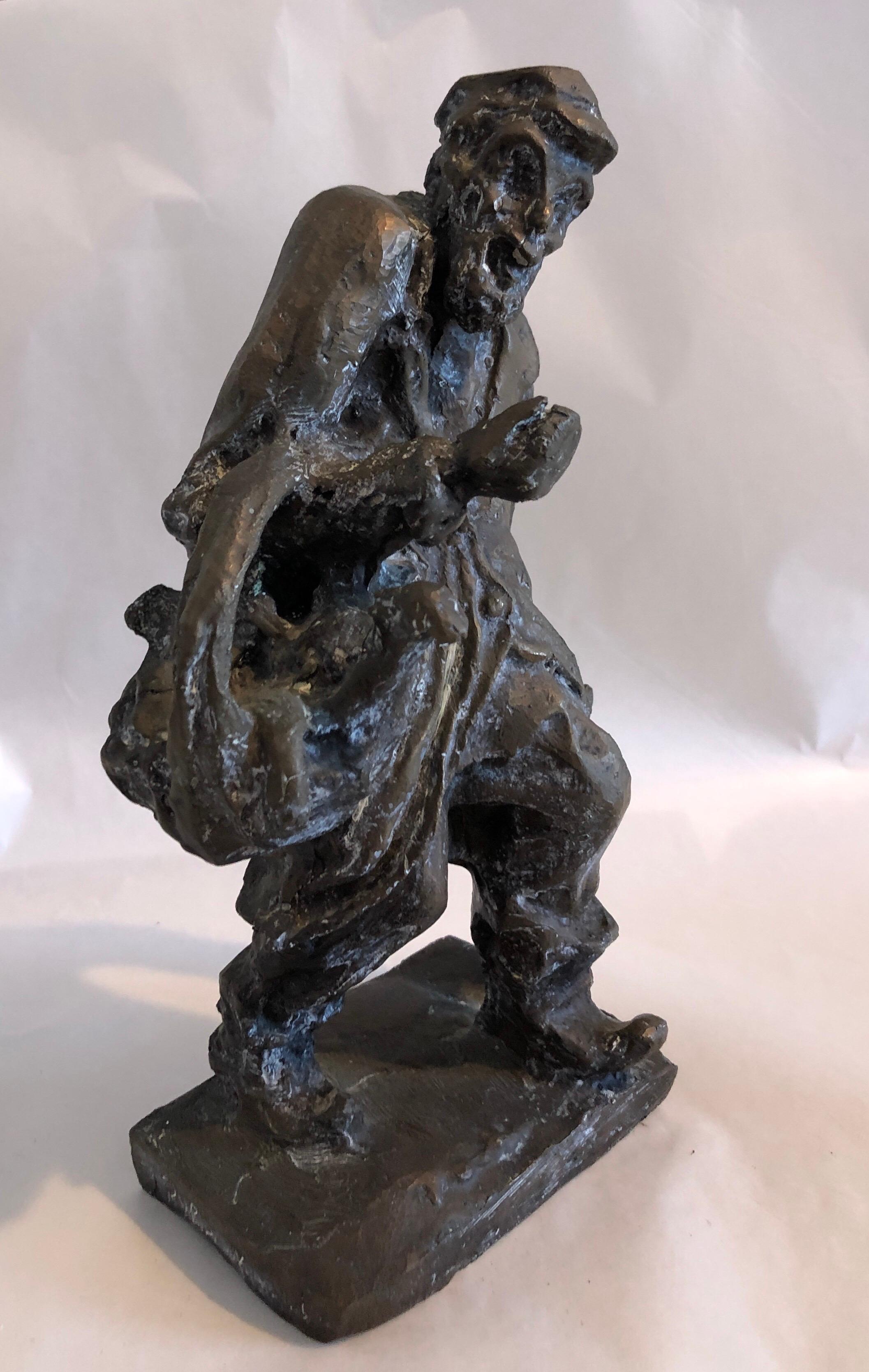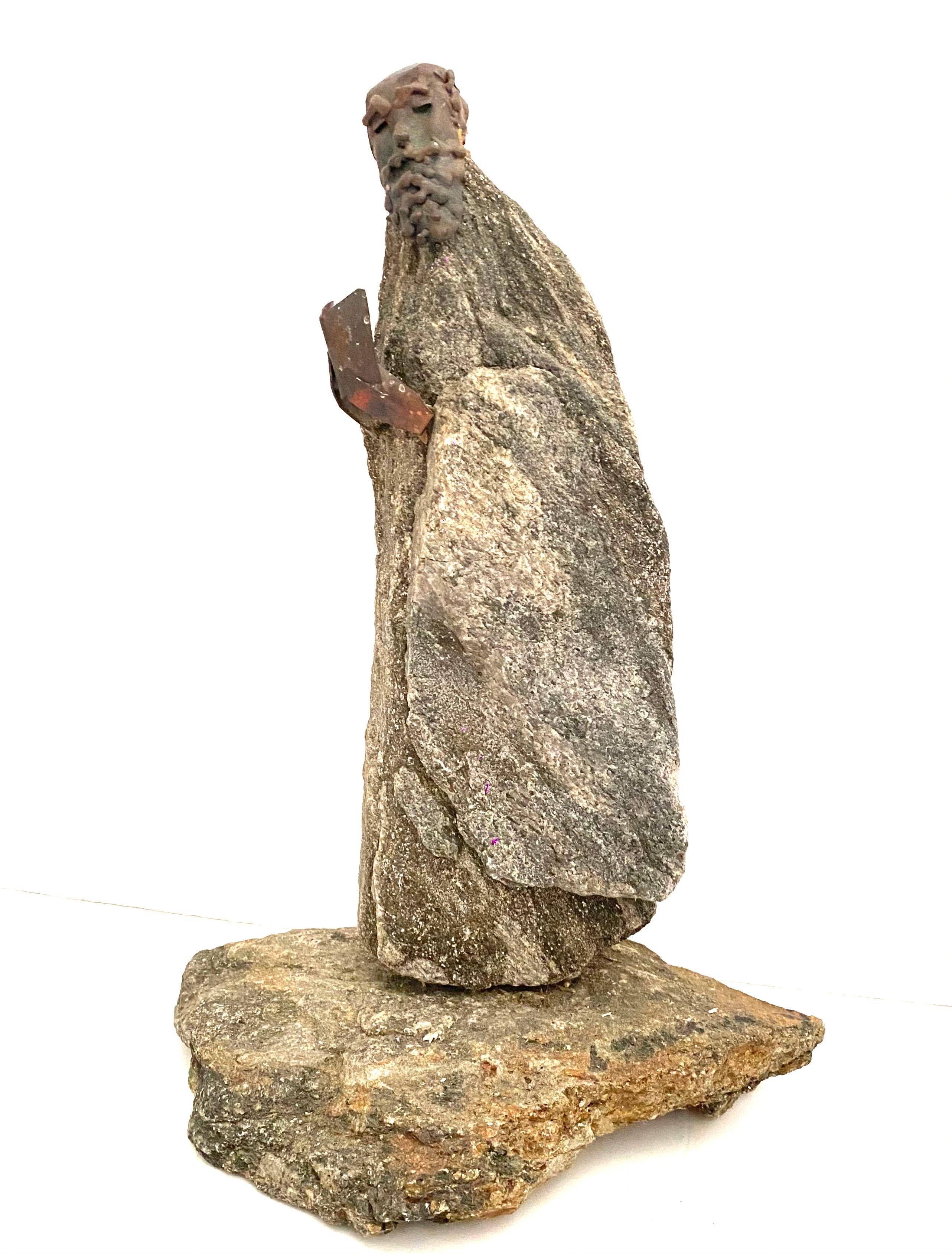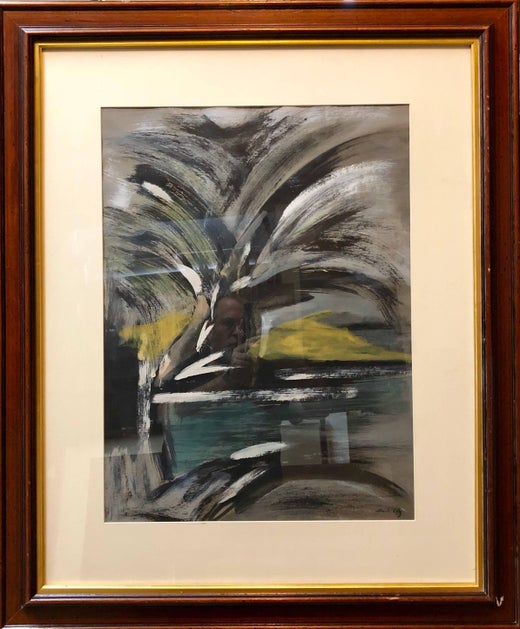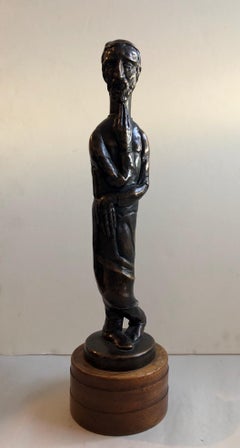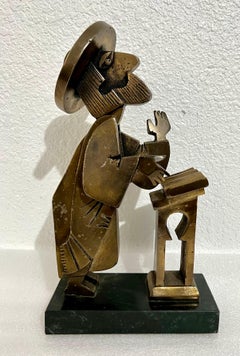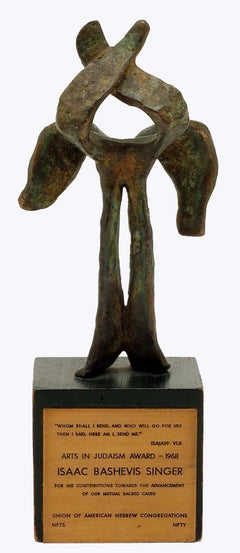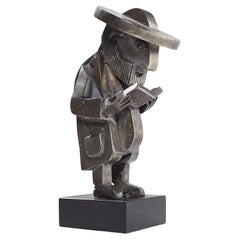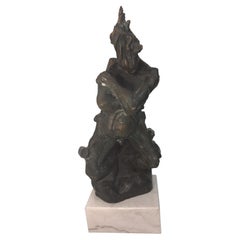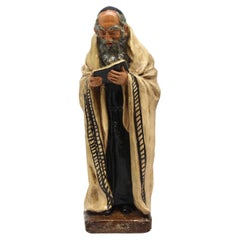Items Similar to French Painted Maquette for Sculpture Judaica Klezmer Musician
Want more images or videos?
Request additional images or videos from the seller
1 of 9
Mane KatzFrench Painted Maquette for Sculpture Judaica Klezmer Musician
$3,000
£2,277.97
€2,605.03
CA$4,191.44
A$4,661.79
CHF 2,434.24
MX$56,729.03
NOK 31,088.99
SEK 29,155.99
DKK 19,442.34
Shipping
Retrieving quote...The 1stDibs Promise:
Authenticity Guarantee,
Money-Back Guarantee,
24-Hour Cancellation
About the Item
Mane-Katz (1894-1962) maquette plaster relief for bronze sculpture. (it is made from sort of composite material and then painted or colored from the casting. there is no foundry mark or info. it is signed Mane Katz verso but I do not know if it is the artist's hand.
Emmanuel Mané-Katz (Hebrew:מאנה כץ), born Mane Leyzerovich Kats (1894–1962), was a Litvak painter born in Kremenchuk, Ukraine, best known for his depictions of the Jewish shtetl in Eastern Europe.
Mane-Katz moved to Paris at the age of 19 to study art, although his father wanted him to be a rabbi. During the First World War he returned to Russia, at first working and exhibiting in Petrograd; following the October revolution, he traveled back to Kremenchuk, where he taught art. In 1921, due to the ongoing fighting in his hometown during the civil war, he moved once again to Paris. There he became friends with Pablo Picasso and other important artists, and was affiliated with the art movement known as the School of Paris; together with other outstanding Jewish artists of that milieu, he is sometimes considered to be part of a group referred to specifically as the Jewish School of Paris. Includes painters Jankel Adler, Arbit Blatas, Marc Chagall, Jacques Chapiro, Michel Kikoine, Pinchus Kremegne, Sigmund Menkees, Jules Pascin, Issachar Ryback, Jacques Lipchitz,Chana Orloff, and Ossip Zadkine. Ecole de Paris
In 1931, Mane-Katz's painting The Wailing Wall was awarded a gold medal at the Paris World's Fair. Early on, his style was classical and somber, but his palette changed in later years to bright, primary colors, with an emphasis on Jewish themes. His oils feature Hassidic characters, rabbis, Jewish musicians, beggars, yeshiva students and scenes from the East European shtetl.
Mane-Katz made his first trip to Mandate Palestine in 1928, and thereafter visited the country annually. He said his actual home was Paris, but his spiritual home was Eretz Yisrael, the Land of Israel.
Mane-Katz left his paintings and extensive personal collection of Jewish ritual art to the city of Haifa, Israel. Four years before his death, the mayor of Haifa, Abba Hushi, provided him with a building on Mt. Carmel to house his work, which became the Mane-Katz Museum. The exhibit includes Mane-Katz's oils, showing a progressive change in style over the years, a signed portrait of the artist by Picasso dated 1932 and a large collection of Jewish ritual objects.
In 1953, Mane-Katz donated eight of his paintings to the Glicenstein Museum in Safed, whose artists quarter attracted leading Israeli artists in the 1950s and 1960s, and housed some of the country's most important galleries.
- Creator:Mane Katz (1894 - 1962, American)
- Dimensions:Height: 19 in (48.26 cm)Width: 11 in (27.94 cm)Depth: 2.75 in (6.99 cm)
- Medium:
- Movement & Style:
- Period:
- Condition:minor chips to verso possibly original to piece.
- Gallery Location:Surfside, FL
- Reference Number:1stDibs: LU38213119162
Mane Katz
Emmanuel Mané-Katz was a prominent modernist in Paris at the beginning of the twentieth century. He studied at the Beaux Arts Academy in Kyiv, Ukraine. After his extensive travels through Europe (catalyzed by World War I), Mané-Katz eventually settled in Paris, where he befriended Pablo Picasso and other fellow modernists. Many of Mané-Katz’s paintings have deep religious significance and origins, often picturing rabbis, Jewish students, and other Hassidic personas. Such paintings of Jewish folklore are often compared to Marc Chagall’s religiously-influenced art practice. He continued his travels to places like Israel, Palestine, Brazil, and Japan throughout the rest of his life, maintaining adherence to religious themes and portraiture in his art. The Mané-Katz Museum is located on Mt. Carmel in Haifa, Israel, and his work is part of the permanent collections of the Tate, the MOMA, and the Museum of Art at Ein Harod in Israel. After his death, Mané-Katz donated much of his art to Haifa, Israel, where his home was. His participation in the School of Paris alongside modernists like Picasso, Chagall, and Soutine solidified him as an influential modernist painter in the early twentieth century.
About the Seller
4.9
Platinum Seller
Premium sellers with a 4.7+ rating and 24-hour response times
Established in 1995
1stDibs seller since 2014
1,784 sales on 1stDibs
Typical response time: <1 hour
- ShippingRetrieving quote...Shipping from: Surfside, FL
- Return Policy
Authenticity Guarantee
In the unlikely event there’s an issue with an item’s authenticity, contact us within 1 year for a full refund. DetailsMoney-Back Guarantee
If your item is not as described, is damaged in transit, or does not arrive, contact us within 7 days for a full refund. Details24-Hour Cancellation
You have a 24-hour grace period in which to reconsider your purchase, with no questions asked.Vetted Professional Sellers
Our world-class sellers must adhere to strict standards for service and quality, maintaining the integrity of our listings.Price-Match Guarantee
If you find that a seller listed the same item for a lower price elsewhere, we’ll match it.Trusted Global Delivery
Our best-in-class carrier network provides specialized shipping options worldwide, including custom delivery.More From This Seller
View AllRussian French Judaica Jewish Shtetl Wedding Klezmer Musician Bronze Sculpture
By Mane Katz
Located in Surfside, FL
Bronze Double Bass Player Klezmer Musician Sculpture signed Mane-Katz at base. Numbered 8/8.
-Katz (1894-1962) was a Litvak painter born in Ukraine best known for his depictions of...
Category
1960s Modern Figurative Sculptures
Materials
Bronze
Rare Vintage Israeli Judaica Rabbi Klezmer Violinist Sculpture Frank Meisler Art
By Frank Meisler
Located in Surfside, FL
Rare Vintage unusual piece.
In this bronze or metal sculpture by Frank Meisler, the artist depicts a Klezmer violin player The figure seems cartoon-like with exaggerated facial featu...
Category
1960s Folk Art Sculptures
Materials
Stone, Metal
Art Deco Expressionist Bronze Judaica Rabbi Sculpture Los Angeles Modernist
By Peter Krasnow
Located in Surfside, FL
Bronze Jewish Rabbi. Original Patina. Art-deco wood carved base. It is signed with initials P.K. and marked "Calif Art Bronze Fdry LA" (California Art Bronze Foundry Los Angeles). it is not dated.
PETER KRASNOW (1886-1979), Russian-Ukrainian, American artist painter and sculptor, born Feivish Reisberg, was a California modernist and colorist artist known for his abstract wood sculptures and architectonic hard-edge paintings and drawings which were often based on Hebrew calligraphy and other subjects related to his Jewish heritage...
Category
1930s Expressionist Figurative Sculptures
Materials
Bronze
Rare Vintage Israeli Judaica Rabbi Praying Mechanical Sculpture Frank Meisler
By Frank Meisler
Located in Surfside, FL
Rare Vintage unusual piece.
In this bronze or metal sculpture by Frank Meisler, the artist recreates a Rabbi at prayer. The figure seems cartoon-like with exaggerated facial features...
Category
1960s Folk Art Sculptures
Materials
Stone, Metal
Bronze Judaica Expressionist Sculpture Russian Jewish Shtetl Goose Peddler
By Issachar Ryback
Located in Surfside, FL
A cast bronze sculpture depicting an elderly jewish peddler carrying a basket of geese going to the shtetl market. Signed on base. This is not editioned...
Category
20th Century Expressionist Figurative Sculptures
Materials
Bronze
Polish Sculpture Granite Stone, Metal Judaica Jewish Holocaust Memorial Art
By Lubomir Tomaszewski
Located in Surfside, FL
Born in 1923, alumnus of the Warsaw Academy of Fine Arts. Student of the Warsaw University of Technology, is an extraordinary artist, searching for his own artistic way. Ambitious,...
Category
20th Century Modern Figurative Sculptures
Materials
Stone, Iron
You May Also Like
Bronze Sculpture to Isaac Bashevis Singer, Arts in Judaism Award signed Judaica
By Nathaniel Kaz
Located in New York, NY
Nathaniel Kaz
Bronze Sculpture to Isaac Bashevis Singer for Arts in Judaism Award, 1966
Bronze, Square wooden base, Metal tag
Signed and dated "66" to back of bronze portion of the w...
Category
1960s Abstract Expressionist Abstract Sculptures
Materials
Metal, Bronze
Frank Meisler Rare Vintage Judaica Rabbi Praying Mechanical Sculpture 103/250
By Frank Meisler
Located in Countryside, IL
Frank Meisler Rare Vintage Judaica Rabbi Praying Mechanical Sculpture 103/250
This sculpture measures: 4 wide x 5 deep x 9.75 high
We take our photos in a controlled lighting studi...
Category
Early 2000s Israeli Modern Figurative Sculptures
Materials
Metal
Mounted Figural Bronze Sculpture by Elias Lifshitz
Located in North Miami, FL
This is an outstanding early bronze figural sculpture reminiscent of Henry Moore, executed by a lifelong sculptor Elias Lifshitz. "I am King of Creation"
Base only: 7 x 8.5, 3.5 in...
Category
Vintage 1960s American Brutalist Figurative Sculptures
Materials
Marble, Bronze
A Vintage Marwal Chalkware Rabbi Sculpture, New York, Circa 1960s
Located in New York, NY
A charming and expressive vintage sculpture by Marwal Industries, this piece was created in New York during the 1960s, and is a fine example of chalk...
Category
Vintage 1960s American Sculptures and Carvings
Materials
Plaster
Arnold Henry Bergier Moses Sculpture, 1967
Located in New York, NY
This is a bust of Moses shown carrying two stone Decalogues after the giving of the Torah on Mount Sinai. The piece has a wonderful natural carved appearance that brings out Moses's countenance and attire.
Arnold Henry Bergier (1914-2007) * A sculptor, collagist, and caricaturist; his sculptures include portraits from life of prominent persons, works for synagogues and churches, and public buildings.
Bergier sang in the Metropolitan Opera chorus as a young man and in 1938 he went to Paris where he studied art with Camilo Egas...
Category
Vintage 1960s American Figurative Sculptures
Materials
Ceramic
$1,616 Sale Price
20% Off
Sculpture Sculpted Face Liliana Casella Muratti 1970s
Located in Taranto, IT
This intense wood sculpture signed Liliana Casella Muratti depicts a strongly expressive human face, modeled in a dry and fragmented plastic language. The artist seems to want to con...
Category
Vintage 1970s Italian Expressionist Sculptures and Carvings
Materials
Marble
More Ways To Browse
Large Plaster Sculpture
Plaster Relief
Bronze Musician
French Plaster Relief
Plaster Relief Wall Sculpture
Large Plaster Relief
Plaster Maquette
Bronze Sculpture Mane Katz
Willitts Design
Wizard Of Clay
Yves Klein Pompon
Abell Octovan
Alfonso Castillo Orta
Alhambra Facade
Andrew Kazantsev
Andy Warhol Dunny
Anton Chotka
Bear Sahara Novotny
